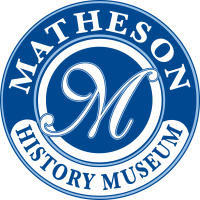Weaving a Community: 30 Years of the Matheson History Museum
Mary Ann Cofrin Exhibit Hall

In the late 1980s, Gainesville had a well-documented and researched history, numerous nationally-recognized historical sites, and multiple civic organizations centered around the preservation and proliferation of local history. What it did not have was a centralized place dedicated to that rich local history, where the accumulated knowledge and artifacts of the last two centuries could be housed and protected. This year, the Matheson History Museum will commemorate its 30th Anniversary of meeting that need.
To celebrate, Weaving a Community will take an all-encompassing view of the Matheson’s history and its origins. The exhibition reveals the museum’s roots through the history of the Matheson family, the American Legion Hall, and the wider civil society. It presents our history in an unbroken tapestry, revealing interesting and intertwined threads that tie the museum, the history of Gainesville, and our community together.
Curator: Willett Hancock, Museum Assistant, Matheson History Museum
Graphic Designer: Rick Kilby, https://www.rickkilby.com/
Return to Forever: Gainesville’s Great Southern Music Hall
Presented by Meldon Law
Main Exhibit Hall
LAST DAY: Saturday, June 8

Between 1974 and 1978, the top concert venue in Gainesville was the Great Southern Music Hall, located inside the historic Florida Theatre at 233 West University Avenue. Jeffrey Meldon and Jim Forsman purchased the venue and transformed it into a state-of-the-art concert hall spotlighting national artists of legendary status, those who had cult followings – and others they just plain liked. The Great Southern played host to a who’s who of prestigious performers including Jimmy Buffett, Ray Charles, Muddy Waters, Bob Seger, Steve Martin, Ike and Tina Turner, John Prine, the Count Basie Orchestra, Weather Report, Randy Newman, Rush, Cheech & Chong and dozens more.
This impactful exhibit showcases dozens of John Moran‘s performance photos from his two years as the Great Southern Music Hall house photographer. Also featured is a display of Bo Diddley artifacts, including one of Bo’s signature square box guitars. Written by music journalist Bill DeYoung and designed by historian Rick Kilby, this unique exhibit celebrates a golden age in the University City’s musical history, the likes of which may never be seen again.
Thank you to Jeffrey Meldon and Meldon Law for sponsoring this exhibition!
When Johnny Came Marching Home: Some Gave All – All Gave Some
by Ken McGurn and Matthew Pollard
Outdoor Exhibition – located on the west side of the main Matheson building behind the set of flag poles along Sweetwater Branch

This sculpture was designed by Ken McGurn and fabricated by Matthew Pollard. In partnership with the Matheson, the City of Gainesville and Ken McGurn the artwork will remain here for a year or more. Next time you’re downtown spend a few minutes viewing the artwork and remembering those who came home from war with both physical and mental wounds.
McGurn: “We honor the dead, but often ignore the wounds, both physical and mental, carried by those who returned. I did this to remind people that war leaves wounds and to heal some of my own memories. The first represents the soldier in his shiny new uniform marching off to war, rifle over his shoulder. The second is unfinished, rusting brown representing the soldier as he patrols in the jungle, rifle across his chest in the ready position. The third is the soldier home from war. The ‘rifle’ is now a crutch where his missing a leg. The material is steel representing the soldier’s strength.”
Ken McGurn served in the Army and Army Reserves from 1963 to 1979. He was deployed to Vietnam in 1965 and Germany from 1968-1970. We honor all of those who served.
